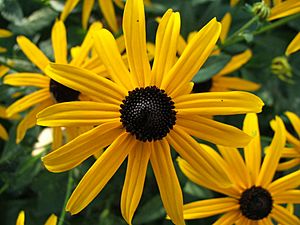Orange coneflower facts for kids
Quick facts for kids Orange coneflower |
|
|---|---|
 |
|
| Scientific classification | |
| Genus: |
Rudbeckia
|
| Species: |
fulgida
|
Rudbeckia fulgida, also known as the orange coneflower or perennial coneflower, is a beautiful flowering plant that grows naturally in eastern North America. It's part of the Asteraceae family, which includes many daisy-like flowers.
Contents
Description
This plant is an herbaceous perennial, meaning it's not woody and comes back year after year. It can grow up to 120 cm (about 4 feet) tall. Its flowers look like bright yellow daisies with a dark center, which is why it's called a "coneflower."
How it Grows and Spreads
Rudbeckia fulgida can spread in two main ways. It uses special stems called stolons that grow along the ground and can root to form new plants. It also produces seeds. These seeds are found in small fruits called cypselae, which are about 2.2 to 4 mm long.
When the seeds are ripe, they are a favorite food for finches, especially in winter.
What it Looks Like
The stems of the orange coneflower are usually hairy, ridged, and dark green. Its leaves are also dark green and have a slightly rough texture. They are simple leaves with slightly jagged edges.
The flowers are the most striking part! They are shaped like heads, with a dark, almost black center made of many tiny "disk florets." Around this dark center are bright orange "ray florets," which look like petals. These flowers usually grow one per stem, standing tall above the leaves.
Etymology (Where the Name Comes From)
The name Rudbeckia was given to honor Linnaeus's mentor, Olaus (Olaf) Rudbeck (1630-1702), and his son Olof Rudbeck (1660-1740). Both were professors who studied plants at Uppsala University.
The word Fulgida means 'flashing' or 'glowing'. It comes from the Latin word 'fulgidus', which means 'brightly colored'. This perfectly describes the bright orange flowers!
Cultivation (How People Grow It)
There are seven different types, or varieties, of Rudbeckia fulgida:
- Rudbeckia fulgida var. deamii
- Rudbeckia fulgida var. fulgida
- Rudbeckia fulgida var. palustris
- Rudbeckia fulgida var. spathulata
- Rudbeckia fulgida var. speciosa
- Rudbeckia fulgida var. sullivantii
- Rudbeckia fulgida var. umbrosa
Two of these varieties, Rudbeckia fulgida var. deamii and R. fulgida var. sullivantii 'Goldsturm', have won the Royal Horticultural Society's Award of Garden Merit. This award means they are excellent plants for gardens.
To help these plants flower well, they often need a period of cold, called Vernalization. Here are some recommendations for popular types:
- 'Goldsturm' needs 10–12 weeks at about 40 °F (4.4 °C).
- 'Little Goldstar' needs 10 weeks below 40 °F (4.4 °C).
- 'Pot of Gold' needs 10 weeks at 35-41 °F (1.7-5 °C).

